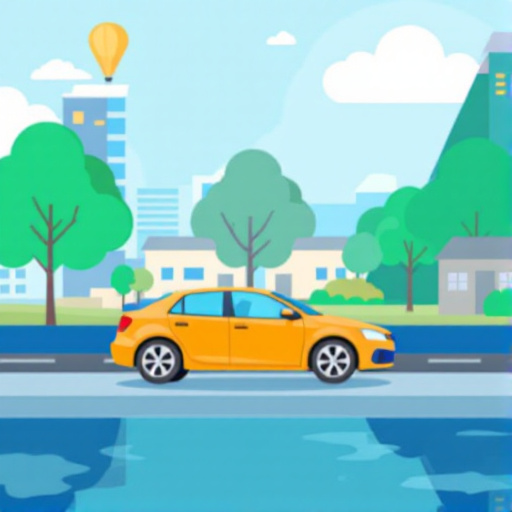Related Articles
- Unveiling the Unthinkable: How Your Social Media Posts Could Impact Your Car Insurance Premiums
- "From Showroom to Social Media: How Dealerships are Becoming Digital Storytellers in 2023"
- "From Showroom to Stream: The Rise of Virtual Reality Test Drives at Dealerships"
- Revving Up Sales: How Virtual Reality is Transforming the Dealership Experience for Shoppers and Sellers Alike
- Selling Experiences: How Dealerships Can Transform into Immersive Automotive Entertainment Hubs
- The Surprising Impact of Your Credit Card Habits on Car Financing: What You Didn't Know!
The Surprising Impact of Climate Change on Car Insurance Premiums: What Drivers Need to Know
The Surprising Impact of Climate Change on Car Insurance Premiums: What Drivers Need to Know
Climate change isn’t just altering the environment; it’s also reshaping how we think about car insurance premiums. As natural disasters become more frequent, drivers need to understand the surprising ways climate change is driving up costs.
The Climate Connection
First, let’s talk about the elephant in the room: climate change. According to the Intergovernmental Panel on Climate Change (IPCC), global temperatures have already risen by about 1.1°C since the pre-industrial era, leading to more extreme weather events (IPCC, 2021). With this increase comes an uptick in the frequency and severity of hurricanes, wildfires, floods, and other disasters that can wreak havoc on a vehicle.
The Rising Costs of Disasters
Ever heard of the insurance term “catastrophic losses”? Natural disasters have caused insurers to pay out billions. In 2020 alone, the U.S. suffered from a record-breaking $95 billion in insured losses due to disasters like hurricanes and wildfires (National Oceanic and Atmospheric Administration, 2021). Premiums are soaring as a result, with insurers redistributing costs to policyholders across the board.
A Story of Change
Meet Sarah, a 31-year-old school teacher living in California. Sarah loved her two-door car, purchased with her first paycheck. When the wildfires raged nearby last year, she thought her car was insured. But after her insurance company increased her premiums by 30% due to the increasing fire risk in her area, she felt betrayed. This is not just Sarah's story; it's the tale of many Americans facing the consequences of climate change.
Why Are Premiums Going Up?
Insurance companies base premiums on risk assessment. Higher risks lead to higher premiums. What’s causing the surge? It’s the increasingly acute damage from climate-related events. According to a study by the Insurance Information Institute, 70% of insurers have cited climate change as a reason for higher premiums (Insurance Information Institute, 2022). And don't forget the pesky repairs that come with increased incidents—more accidents often lead to higher repair costs, contributing to the upward spike in premiums.
Climate Change = MORE Claims
It’s not just about the disasters; it’s also about how often these disasters happen. A staggering statistic is that 60% of Americans have been directly affected by severe weather events in recent years (The Pew Research Center, 2021). Each noted incident in a region can boost the claims filed by residents, triggering an uptick in insurance costs.
Is Your Area at Risk?
Before you dismiss this as a problem for others, find out about your local risk factors. Some locations are inherently more vulnerable to flooding, hailstorms, or wildfires. Websites like FEMA or local government resources provide up-to-date information about risk assessments in specific areas. If you live in a high-risk zone, brace yourself: your car insurance premiums could be climbing faster than a wildfire in the California hills!
The Big Data Play
Interestingly, big data is now a key player in determining insurance rates. Insurers analyze data such as weather patterns, crime rates, and accident statistics to determine risk levels. With climate models becoming increasingly sophisticated, what does this mean for insurance? If the data indicates a rising tide of risk over the coming years, expect your premiums to rise—and quickly. As a 45-year-old data analyst, I've seen how decisions are now more data-driven than ever before, and understanding these shifts can give policyholders an advantage.
Customer Sentiment and Generational Perspectives
The generational divide shows varied perceptions of climate change. Younger drivers, particularly those aged 16-30, are more attuned to the impacts of climate change than their older counterparts. A survey showed that over 65% of millennials believe climate change will affect their insurance premiums (GlobalData, 2023). While older generations might view it as another financial inconvenience, younger drivers see it as a ticking time bomb threatening their wellbeing and driving budget.
Potential Savings Strategies
If your premiums are about to skyrocket, are there ways to save? Absolutely! Here are some strategies to consider:
- Shop Around: Regularly compare rates. You will be surprised at how different insurers assess risk and prices.
- Bundle Policies: Consider bundling car insurance with home or rental insurance for potential discounts.
- Invest in Safety Features: Cars that come equipped with advanced safety features can lower premium costs.
- Consider Taking a Car Insurance Course: Many insurers will reduce your premiums if you have completed a recognized driver safety course.
Insurance Doomsday: A Glimpse into the Future
Looking ahead, some experts warn of what they call “insurance doomsday.” A report from the National Association of Insurance Commissioners forecasts that some areas may become uninsurable due to extreme risk levels, particularly as climate change progresses (NAIC, 2020). This doesn’t just affect homeowners; car owners could find themselves struggling to secure coverage in high-risk zones.
The Argument for Climate Action
But amid all this doom and gloom, let’s think positively! The solution begins with advocacy and awareness. If consumers voice their concerns about insurance increases due to climate change, insurance companies might be compelled to act responsibly. Reduced reliance on fossil fuels and increased support for sustainable transportation initiatives could lead to lower risks—and, eventually, lower premiums. The sky isn’t falling yet, but it’s wise to keep looking up!
Fun Fact: The Car That Could Change Everything
Speaking of sustainability, did you know there’s a car that can actually fight climate change? Enter the 2023 Tesla Model S Hydro-Powered Vehicle—just kidding! That doesn’t exist (yet). But as technology evolves, expect to see innovations in vehicle design and operation that help mitigate climate impacts, paving a way for more affordable insurance rates in the long term.
Final Thoughts
In conclusion, the impact of climate change on car insurance premiums is an undeniable reality. From rising costs due to catastrophic losses to localized risks based on weather patterns, our driving experiences are intertwined with climate trends. As a 24-year-old writer who's watched environmental changes unfold, I urge all drivers—whether young or old—to take notice. Keep an eye on your premiums and advocate for policies that can mitigate climate change. Together, we can drive down the impact on our wallets while working towards a sustainable future!
So, next time you check your insurance bill, remember: the weather outside isn’t just frightful; it’s forecasted to directly affect what you pay for coverage. Stay informed, take action, and let’s navigate the winding roads of this modern climate crisis together!





